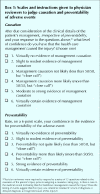The Canadian Adverse Events Study: the incidence of adverse events among hospital patients in Canada
- PMID: 15159366
- PMCID: PMC408508
- DOI: 10.1503/cmaj.1040498
The Canadian Adverse Events Study: the incidence of adverse events among hospital patients in Canada
Abstract
Background: Research into adverse events (AEs) has highlighted the need to improve patient safety. AEs are unintended injuries or complications resulting in death, disability or prolonged hospital stay that arise from health care management. We estimated the incidence of AEs among patients in Canadian acute care hospitals.
Methods: We randomly selected 1 teaching, 1 large community and 2 small community hospitals in each of 5 provinces (British Columbia, Alberta, Ontario, Quebec and Nova Scotia) and reviewed a random sample of charts for nonpsychiatric, nonobstetric adult patients in each hospital for the fiscal year 2000. Trained reviewers screened all eligible charts, and physicians reviewed the positively screened charts to identify AEs and determine their preventability.
Results: At least 1 screening criterion was identified in 1527 (40.8%) of 3745 charts. The physician reviewers identified AEs in 255 of the charts. After adjustment for the sampling strategy, the AE rate was 7.5 per 100 hospital admissions (95% confidence interval [CI] 5.7- 9.3). Among the patients with AEs, events judged to be preventable occurred in 36.9% (95% CI 32.0%-41.8%) and death in 20.8% (95% CI 7.8%-33.8%). Physician reviewers estimated that 1521 additional hospital days were associated with AEs. Although men and women experienced equal rates of AEs, patients who had AEs were significantly older than those who did not (mean age [and standard deviation] 64.9 [16.7] v. 62.0 [18.4] years; p = 0.016).
Interpretation: The overall incidence rate of AEs of 7.5% in our study suggests that, of the almost 2.5 million annual hospital admissions in Canada similar to the type studied, about 185 000 are associated with an AE and close to 70 000 of these are potentially preventable.
Figures



Comment in
-
Health care as a risk factor.CMAJ. 2004 May 25;170(11):1688-9. doi: 10.1503/cmaj.1040690. CMAJ. 2004. PMID: 15159368 Free PMC article. No abstract available.
-
Canadian Adverse Events Study.CMAJ. 2004 Oct 12;171(8):829, 832; author reply 834. doi: 10.1503/cmaj.1040919. CMAJ. 2004. PMID: 15477606 Free PMC article. No abstract available.
-
Canadian Adverse Events Study.CMAJ. 2004 Oct 12;171(8):832; author reply 834. doi: 10.1503/cmaj.1041078. CMAJ. 2004. PMID: 15477609 Free PMC article. No abstract available.
-
Canadian adverse events study.CMAJ. 2004 Oct 12;171(8):833-4; author reply 834. doi: 10.1503/cmaj.1040920. CMAJ. 2004. PMID: 15477610 Free PMC article. No abstract available.
-
Canadian Adverse Events Study.CMAJ. 2004 Oct 12;171(8):833; author reply 834. doi: 10.1503/cmaj.1040857. CMAJ. 2004. PMID: 15477611 Free PMC article. No abstract available.
-
Canadian Adverse Events Study.CMAJ. 2004 Oct 12;171(8):834; author reply 834. doi: 10.1503/cmaj.1040918. CMAJ. 2004. PMID: 15477613 Free PMC article. No abstract available.
-
Hear some evil, see some evil, report no evil.CMAJ. 2010 Aug 10;182(11):1214. doi: 10.1503/cmaj.110-2080. CMAJ. 2010. PMID: 20696812 Free PMC article. No abstract available.
References
-
- Brennan TA, Leape LL, Laird NM, Hebert L, Localio AR, Lawthers AG, et al. Incidence of adverse events and negligence in hospitalized patients. Results of the Harvard Medical Practice Study I. N Engl J Med 1991;324(6):370-7. - PubMed
-
- Wilson RM, Runciman WB, Gibberd RW, Harrison BT, Newby L, Hamilton JD. The Quality in Australian Health Care Study. Med J Aust 1995; 163 (9): 458-76. - PubMed
-
- Leape LL, Brennan TA, Laird N, Lawthers AG, Localio AR, Barnes BA, et al. The nature of adverse events in hospitalized patients. Results of the Harvard Medical Practice Study II. N Engl J Med 1991;324(6):377-84. - PubMed
-
- Thomas EJ, Studdert DM, Burstin HR, Orav EJ, Zeena T, Williams EJ, et al. Incidence and types of adverse events and negligent care in Utah and Colorado. Med Care 2000;38(3):261-71. - PubMed
-
- Davis P, Lay-Yee R, Briant R, Schug S, Scott A, Johnson S, et al. Adverse events in New Zealand public hospitals: principal findings from a national survey. Wellington: NZ Ministry of Health; 2001. Occasional Paper no 3. Available: www.moh.govt.nz/publications/adverseevents (accessed 2004 Apr 28).
Publication types
MeSH terms
LinkOut - more resources
Full Text Sources
Other Literature Sources
Medical
